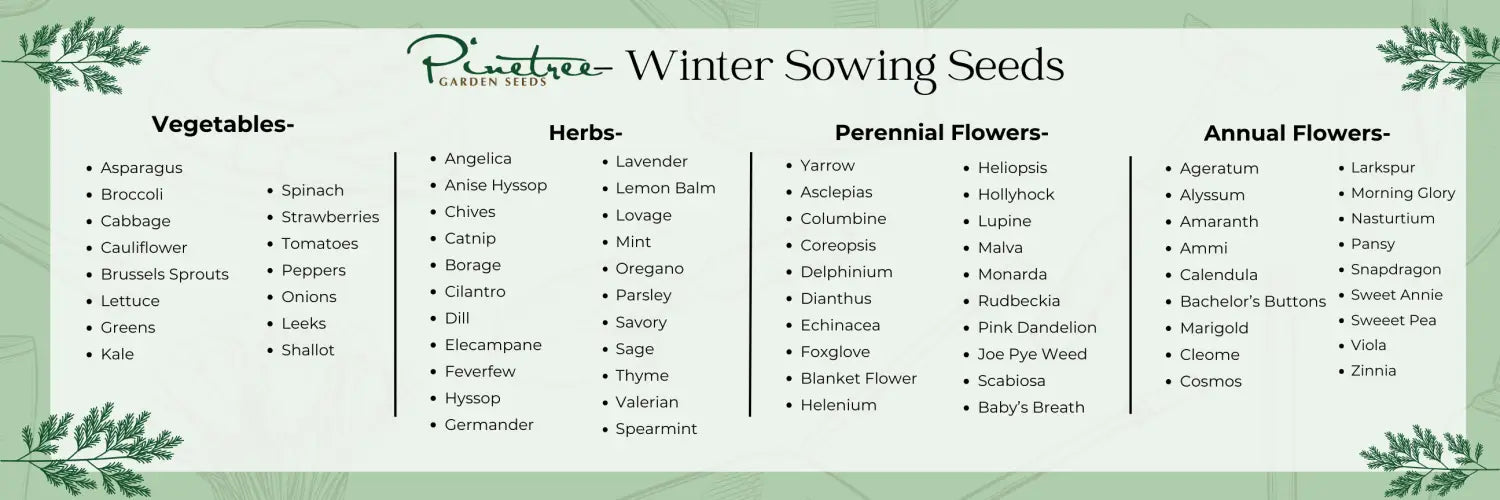Start your seeds outdoors this winter!
Stratification - The process that recreates the temperature conditions that would naturally break a seeds dormancy.
What is winter sowing?
Some seeds need a bit of cold to jumpstart their journey to the garden. This period of chilling and then warming, helps break down the seed coat leading to more successful germination and a happier plant overall. Perennials are big fans of this cold treatment and it's the reason we plant things like garlic in the fall! Though it can be recreated using a refrigerator, our preferred method is winter sowing. It's simple to do, inexpensive, saves space and doesn't require any fancy equipment. Plus, you won't have to worry about hardening off your seedlings which can be a delicate process.
It's an excellent way to beat the winter blues. Each time you walk by your milk jug greenhouses, you'll be filled with a sense of optimism about the warmer weather ahead.
Here's what you'll need:
- Plastic milk jugs, salad containers, or liter bottles. Remove stickers and labels - the tops need to be transparent!
- A box cutter or good pair of scissors
- Duct Tape (or similarly strong packing tape)
- Labels/Markers
- Soil
- Seeds (scroll down to see what types do best)
- Water - a spray bottle is helpful but not mandatory
- A good spot with plenty of natural sunlight
- and a little bit of patience
Directions:
- If using a milk jug or bottle, carefully cut your container in half leaving the top partially attached near the handle (or on one side) to create a hinge - this will help to close your lid later.
- Poke holes in the bottom of your containers using a screw or thumbtack to allow water to move through preventing soggy soil.
- Fill the bottom with 2-3" of soil and water the soil.
- Follow seed packet instructions for sowing depth.
- Water lightly - this is where a spray bottle comes in handy because the top layer doesn't need to be soaked.
- Place your labels inside so they won't be destroyed by the elements.
- Seal your container by taping the top half to the bottom half with weatherproof/waterproof tape.
- Place your mini-"greenhouses" somewhere outside where they'll get plenty of sun.
Now let nature do it's thing - time for you and your seeds to just....chill😎
Watch Matthew demonstrate how to winter sow in our latest YouTube Video:
Which seeds we winter sow and when:
Scroll down for a downloadable PDF!
January
Flowers: Aquilegia (Columbine), Coreopsis, Delphinium, Joe Pye (Eupatorium), Milkweed (Asclepias)
Herbs: Angelica, Anise Hyssop, Catnip, Elecampane, Feverfew, Hyssop, Germander, Oregano, Valerian, Spearmint
Fruits and Vegetables: Asparagus, Onions, Leeks, Sea Kale, Shallots, Strawberries
February
Flowers: Ageratum, Baby's Breath, Bishop's Flower (Ammi / False Queen Anne's Lace), Cleome, Dianthus, Echinacea, Foxglove, Blanket Flower (Gaillardia), Helenium, Heliopsis, Hollyhock, Larkspur, Lupine, Malva, Monarda (Bee Balm), Rudbeckia, Pink Dandelion, Pansy, Snapdragon, Sweet Annie, Sweet Pea, Viola
Herbs: Borage, Chives, Cilantro, Dill, Lavender, Lemon Balm, Lovage, Mint, Oregano, Parsley, Savory, Sage, Thyme
Vegetables: Onions, Leeks, Shallots
March
Flowers: Alyssum, Amaranth, Calendula, Bachelors' Buttons, Marigold, Cosmos, Morning Glory, Nasturtium, Scabiosa, Zinnia
Vegetables: Broccoli, Cabbage, Cauliflower, Brussels Sprouts, Lettuce, Leafy Greens, Kale, Spinach, Tomatoes, Peppers
The above are just suggestions from our gardeners to get you started. Be brave and experiment with a few seeds you know need a cold treatment or an early start to the season.
Answers to your FAQ's can be found HERE
And be sure to lettuce know how things grow!!
Winter Sowing List PDF Landscape
Winter Sowing List PDF Standard



Thank you for the info.
Does winter sowing seeds mean that the emerging plants will be frost tolerant?
Matthew is very clear and to the point. He’s doing a great job!
Hi, John!
We’re so happy to hear that! And we absolutely do have some seed starting resources for you, I’ll link those down below.
“Pinetree’s Guide to Seed Starting” – https://www.superseeds.com/blogs/know-your-roots/pinetrees-guide-to-seeds-starting
“Digging Deeper into Seed Starting” – https://www.superseeds.com/blogs/know-your-roots/in-depth-seed-starting
“Transplanting Seedlings” – https://www.superseeds.com/blogs/know-your-roots/transplanting-seedlings
Hope these help! :) As always, feel free to reach out with more questions!
Dear Pinetree:
I recently purchased 4x of your Silver Cup seeds. I am a first time client from your website and I have been very impressed.
I have been studying up on Peat Pots and Seedlings grown inside until Spring. I have purchased dome lights, heating pad and elevated lamp holder from JumpStart. Do you have a link or other source of information on how best to create seedlings from your seeds?
THANKS! JOHN